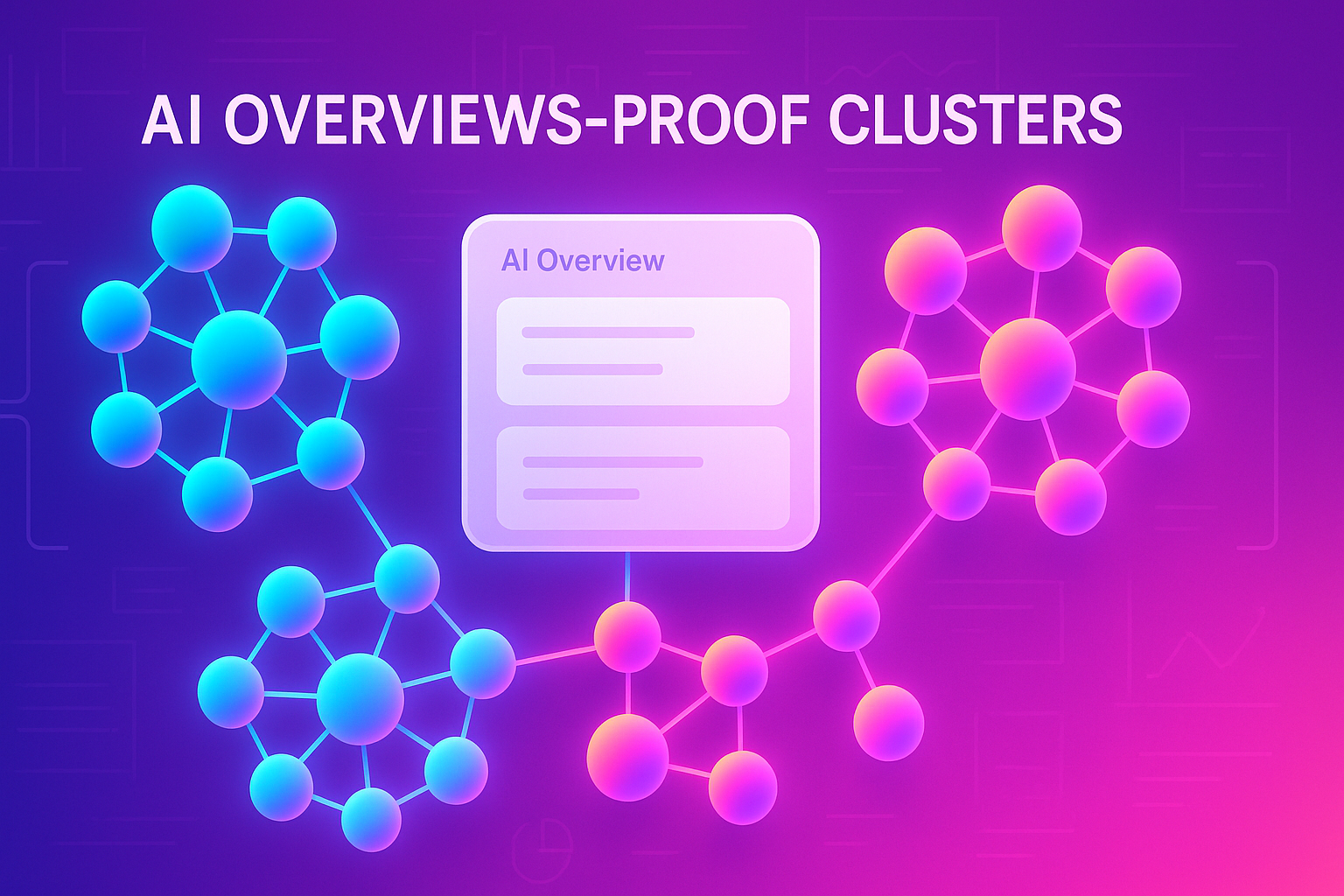A 2025, field-tested playbook to make your topical clusters resilient to AI Overviews/SGE: entity-first architecture, evidence blocks, schema governance, and measurement.
AI Overviews (SGE) Proof Your Topical Clusters Strategy (2025)
Introduction
AI Overviews compress intent and reward sources with clear entities, stable structure, and visible evidence. This practical guide shows how to harden your topical clusters so they’re still cited in SGE—and still convert in 2025. Ship the checklist, verify with SEO Horizan tools, and iterate fast.
1. Start with Entity-First Topic Mapping
Replace keyword lists with entity → task → evidence. Model the real thing users care about (product, problem, concept), the tasks they perform, and the proof they need.
- Pillar (entity hub): Define scope, decisions, and related concepts.
- Spokes (one task each): how-to, compare, troubleshoot, buyer’s guide, glossary.
- Proof assets: step tables, mini-benchmarks, concise FAQs, owner-verified stats.
Example: Instead of “best CRMs,” build a CRM Selection pillar with spokes like “CRM vs CDP,” “How to migrate,” and “Implementation checklist,” plus a benchmark of data sync speeds.
2. Pillar Titles, H1s & Snippets Built for SGE
AI Overviews lift compact, unambiguous fragments. Make your pillar and spokes win a single task decisively and state it in the first 55 words under the H1.
- Title Tag: Decision phrase first; keep ≲60 chars. Preview in Google Search Preview.
- Snippet paragraph: 40–55 words; audience + task + outcomes; plain English.
- Confirm presence/wording via Website Text Extractor.
<p class="snippet">[audience], [task/outcome], [2–3 proof modules you include: steps, benchmark, FAQ].</p>3. Cluster Structure & Heading Hygiene
SGE favors legible hierarchies. Use one H1 per page; keep H2s for major decisions/tasks and H3s for steps/examples. Align anchors to task verbs.
- Map each spoke to a single intent (e.g., “Set up webhooks,” not “webhooks guide everything”).
- Use descriptive anchors for deep links (e.g.,
#error-codes). - Cross-link sibling spokes to route laterally between alternatives.
4. Experience-Led Evidence (what SGE can quote)
Short, verifiable fragments outrank vague prose. Add modules SGE can safely cite:
- Step tables: one row per step with expected result and time.
- Mini-benchmarks: inputs, version, date, and output snapshot.
- FAQ snippets: tight Q→A blocks beside friction points (limits, pricing, errors).
- Owner-verified stats: show sample size and collection window.
5. Image Optimization & Alt Text (for extractability)
Use diagrams and screenshots that clarify tasks; make them machine-legible and fast.
- Descriptive filenames + natural alt text: validate via Image Alt Tags Checker.
- Serve
.webp, compress assets; set width/height to avoid CLS. - Add labels on-image for key states (input, output, error).
6. Internal Linking That Does a Job
Treat each link as a control, not confetti. Enforce final 200s and cut chains.
- Hub → spokes: distribute authority and clarify scope.
- Spoke ↔ spoke: move laterally across versions/alternatives.
- Spoke → proof: benchmarks/FAQs near objection points.
- Verify status codes with URL Redirect Checker and headers via HTTP Headers Lookup.
7. Speed, INP & Stability
Fast, stable pages are easier to parse and rank. Target Core Web Vitals—especially INP.
- TTFB < 600 ms (check with TTFB Checker); payload < 2 MB (Page Size Checker).
- Server-render primary content; lazy-load non-critical widgets.
- Minimize long tasks; avoid CLS near headings/tables.
8. Lean Schema Governance (no decoration)
Keep JSON-LD aligned with what’s visible; use stable @id for recurring entities.
Article/BlogPostingfor guides;HowToonly with visible steps;FAQPageonly with visible Q&A.BreadcrumbListon all cluster pages to clarify hierarchy.- Spot-check parity with Website Text Extractor.
9. Mobile UX & Accessibility
Most SGE interactions are mobile-first. Keep tasks legible and tappable.
- Mobile-first layout, generous spacing, accessible tables.
- Don’t bury key actions below heavy embeds; defer non-critical JS.
- Alt text for diagrams; high-contrast labels on images.
Conclusion
SGE doesn’t kill clusters—it punishes fuzzy ones. Build entity-first hubs, ship task-scoped spokes, add visible evidence, and keep the site fast and stable. Validate each release with quick tooling, then expand only where signals are strong.
Pro Tip: Run a free cluster QA with SEO Horizan—check snippet visibility, link hygiene, headers, and page weight in minutes.
FAQs
Do topical clusters still matter with AI Overviews?
Yes—when clusters are entity-first, task-scoped, and backed by verifiable evidence. Those pages are easier for SGE to surface and cite.
What’s the fastest SGE-proofing win?
Add a 40–55 word snippet under H1 and ship two evidence modules (steps + mini-benchmark) on your top spokes.
How big should a cluster be?
Enough to cover decisions and tasks—not every synonym. Many B2B clusters win with 1 pillar, 6–12 spokes, and 3–5 proof assets.
